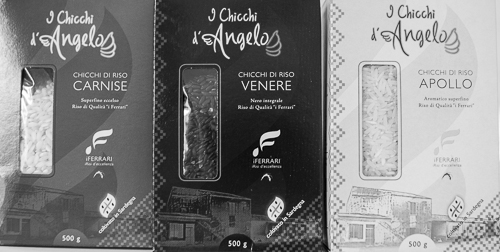It was raining when we arrived at the Ferrari rice farm situated at Pinna Manna a short distance from Oristano where Angelo Ferrari was waiting for us. After having presented ourselves, he started talking about the farm which was founded by his father in 1973, and later turned into a cooperative of Sardinian and Piemontese rice growers. His father, being both an excellent and passionate producer of rice, founded the cooperative at Vercelli in Piemonte, sharing the idea of obtaining better results by using certified seeds. Now the cooperative, which is called SA.PI.SE. (Sardinian-Piemontese Seed Cooperative), and consisting of six members from Sardinia and six from Vercelli, produce and sell rice from certified seeds all over Italy and in some European countries. In fact, they produce rice of excellent quality and regarding rice seeds, the Ferrari farm is the leader in Italy and about to deliver the best products available to the market.
80% of the production of this farm are rice seeds, while the rest is rice for human consumption. Actually, both are derived from the same source, but they are processed differently. The rice which is destined for seeds is selected on the fields, dried in a dryer because it contains lots of water at harvest, then it is sieved in order to get rid of seeds of other plants. Instead, rice for consumption is dried, sent to a rice mill where the husks of the grains of rice are removed, packaged and ready for sale.
Angelo also willingly told us about cultivation of rice, starting with preparation of the fields in late February and early March when the fields are made as level as possible. This is followed by seeding the fields, which depending on the seasons usually takes place between April and June, then the fields are covered with water, but only that which is necessary. During the growing season lasting normally from June to September the rice plants are kept constantly humid, but the fields are not covered with water during fertilisation. Instead, after the water has been drained, the rice plants are fertilised, and water is again let to cover the fields.
When the rice is nearing maturation, the water covering the fields is drained and the fields are let to dry, samples are taken in order to measure the humidity of the rice, which should ideally be 18-20%. Then, weather permitting, the harvest is started. In order to avoid re-germination, the rice (destined for both seeds and human consumption) has to be dried until the humidity is 14% maximum in accordance with the Italian law. The rice is dried either in a horizontal or a vertical drier. In the first one, the rice is stationary in a metal container and a flow of dry air is passed through the rice. This has the disadvantage that the rice facing the air flow is dried more than the rice which is further away. The second type of drier has a vertical container and the rice is moving continuously. When it is falling down, it is subjected to an upcoming airflow. The rice is lifted continuously and allowed to fall repeatedly such that the rice is dried uniformly. Finally, after the drying, the rice is stored in silos, ready for sale.
The rice fields of the Ferrari farm are located next to the sea and it’s an ideal climate for the rice which is allowed to breathe and develop in a healthy way being surrounded by strong sunlight, continuous winds and a salty air. This environment lets the growers refrain from applying any pesticides against mould and micro-toxins.
In fact, the climate of Sardinia leads to that the rice has characteristics different from rice produced in other parts of Italy. The particular characteristics include: higher contents of proteins and starch, robust grains, and not to forget the quality of a healthy, tasty, and aromatic product without using any genetically modified organisms.
The Ferrari farm has been growing and selling rice for about thirty years and during the last two years they have created their own brand called “The grains of Angelo”, having selected the three best rice varieties among which are the black rice Venere (the only black, aromatic rice in Europe), the Carise rice, and the Apollo rice.
The Carnise rice is a new variety of risotto cultivated in Sardinia at the Ferrari farm with high quality grains, which maintain an optimum capacity for cooking.
The Apollo rice is a white, aromatic rice characterised by long grains and a pleasant aroma, very similar to Basmati rice.
The Venere rice has a colour of ebony, it has a high content of nutritious elements and it is aromatic.
The rice which is being commercialised with the brand “The grains of Angelo” is sold, for the time being, mostly in Sardinia and northern Europe.
Angelo kindly gave us one package each of “The grains of Angelo”, a gift which was highly appreciated.

